2011 Volkswagen Touareg – Click above for high-res image gallery
The outgoing Volkswagen Touareg range has always lived on the wrong side of the tracks in America. It was a big, expensive Volkswagen. Notice that we can't just say it was a big, expensive vehicle, because those adjectives are almost as much the norm as anything else – we must qualify those descriptors with the word "Volkswagen." And we can't help but think that's part of the reason this go-almost-anywhere SUV never really made a splash anywhere in the U.S. except in puddles.
The new 2011 Touareg is roomier, more powerful, more efficient and lighter. Much lighter. That's how we like our VWs. And now it comes in hybrid form. We spent a few hours in one to see what a Touareg reset looks like. Our first impressions: So good, this is what the first Touareg should have been like. Follow the jump for the story.
Photos by Jonathon Ramsey / Copyright ©2010 Weblogs, Inc.
Car buying is a little different in Europe than it is in America. Consumers take home an order sheet and lovingly choose each option, then submit it to a dealer and wait for weeks for their car to be built. In America, we show up at a dealer lot and expect to get the ride we want right now.
This is one of the reasons that the current Touareg endured a stiff sales climate. With something like 170 build combinations, potential buyers had lottery-like chances of finding the one they wanted on any given day. Play around with the configurator on the VW site and you'll see that even wheel choices will change your interior option selections.
Of course, there has also been the matter of price. Touaregs aren't cheap – again, "for Volkswagens." A 2010 Touareg V6 FSI starts at $40,850, the V6 TDI diesel at $44,350. Add the technology package to the cheaper model to get DVD navigation and you are at $46,850. From there, $50,000 is just a whisper away. VW said buyers were cross shopping the GMC Acadia, and it maxes out at about $47,000 if you throw everything possible at the top-of-the-line SLT2, a vehicle that may be less capable off-road, but it's also significantly larger than the Touareg and seats eight. The Acura MDX is priced similarly to the VW, is a seven-seater and gets about the same miles per gallon... but it has a bit more aspirational clout.
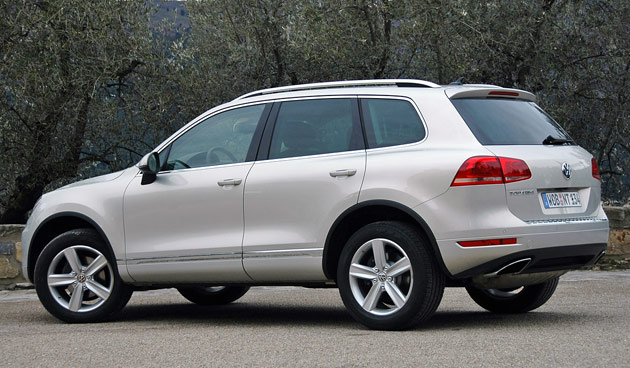
And, of course, there was also the size and the avoirdupois. It isn't small, especially for a dedicated five-seater, and while the Touareg's 4XMOTION air suspension setup could get you just about anywhere – as an eye-opening trip to Moab showed us a couple of years ago – you paid for it in heft and a heavy tiller. As you might have reasonably surmised, folks also shopping Acadias and MDXs aren't usually trying to conquer Hell's Revenge – they wanted to get to the cabin or the after-school sports practice or grandma's house in one piece and a little bit of style. And they don't want to scratch their Galapagos paint while doing it.
When it comes to the raw truths presented by numbers, while 500,000 Touareg and Touareg2 models were sold worldwide, Americans didn't make a good showing as part of that total.
In true Men in Black style, though, you can wipe those memories clean. The old Touareg is gone, and the new one is nothing like it. No, really, nothing. When we asked what was new, we were told "Everything." When we asked for clarification, just to make sure we understood, David Sweet, the general manager for marketing in the U.S., said "It's an entirely new vehicle." Silently, we were sure he added, "What part of the word 'everything' didn't you understand?"
Along with that, the new Touareg's attitude changes more than the vehicle, at least as far as the U.S. is concerned. We don't get most of the high-tech features in this new SUV. A sample of blacked out menu options includes:
- Dynamic Light Assist: camera-based continuous main beam headlight "sees" oncoming traffic and selectively dims and adjusts the direction of each main beam headlight to prevent other drivers, oncoming and in the same direction, from suffering glare. U.S. regulations don't allow the technology.
- Side Assist: a blind-spot warning system that also detects the closing speed of cars approaching you. Not coming because it's expensive and was developed for higher, Autobahn-like closing speeds, not American highways.
- Lane Assist: takes note of the lane you're in, and if you begin to stray sends a mild vibration through the steering wheel. Deemed not cost-effective for American buyers.
- Start/stop on the non-hybrid Touaregs: the tech doesn't count toward the EPA cycle, so VW didn't think it fair to charge for something that has no benefit they could point to on paper.
- Cross Traffic view camera: lets the driver see 90 degrees to the left and right at points located at the very front and rear of the Touareg – i.e. "around the corner." Felt to be more suited to pulling out into narrow European lanes than American driving situations.
- 334-horsepower, 599 pound-feet V8 TDI that replaces the V10 TDI. We get the V6 FSI, V6 TDI and Hybrid.
- 4XMotion: the full-fat four-wheel-drive system with air suspension has been replaced by VW's Torsen limited-slip differential called 4Motion which is lighter and less expensive. It also can't take you as many places as the 4XMotion, but VW realized no one in the U.S. was using their Touaregs as Unimogs.
- Automatic Cruise Control: the same kind of system filtering its way through all kinds of luxury cars, this version works even in stop-and-go traffic. Again, cost is the problem.
We know we've discussed the size thing, so we'll admit right now that the new Touareg is larger. It gets about an inch-and-a-half longer and a half-inch wider, with the front track increased just a hair and the rear track growing by about half an inch as well. It sits a half-inch lower, the lowest SUV in the class other than its sister, the new Porsche Cayenne.
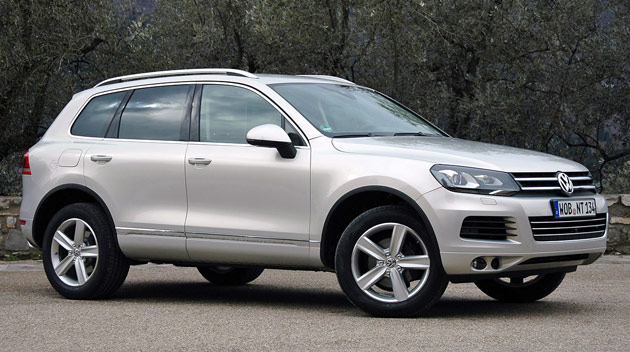
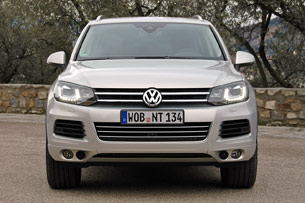
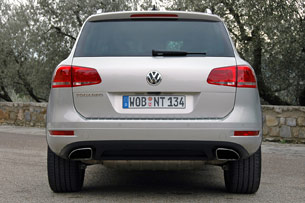
The additional size outside and the 1.5-inch longer wheelbase translates into more roominess inside, with anywhere from 1.75 inches to 2.7 inches more elbow, shoulder and knee room. There is more room for cargo as well, something the previous Touareg didn't exactly lack.
Volkswagen has pulled off this enlargement the right way, though. The new Touareg is about 400 pounds lighter than the last, due to the use of aluminum and high-strength steel, tailored blanks and lighter sound insulation. And yes, that includes the Hybrid. Serious weight loss came from the 4Motion Torsion limited-slip diff setup replacing the 4XMotion air suspension and center and rear differentials. In a case of VW designing a vehicle to be used the way people actually drive it, the hardcore 4XMotion can be ordered as part of a Terrain Tech package, but the 4Motion system alone is left to handle the speed bumps and gravel access roads the average Touareg will find its greatest challenge.
Making sure you'll never be left out in the cold, though, the 4MOTION system has electronic differential locks at all four wheels, 31 degrees of climbing angle and an off-road driving program that tunes the ABS, EDS and ASR for off-road duty, activates Hill Descent Assist and adjusts the automatic gearshift points.
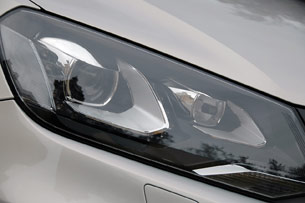
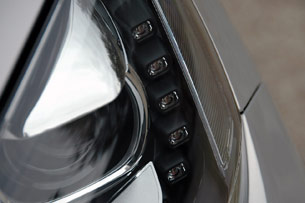
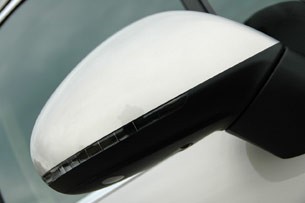
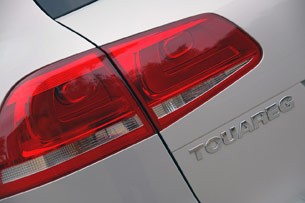
Should you need more – and should you not live in American, as VW has clarified that we won't get it – the Terrain Tech package uses a familiar rotary switch to set the system to one of five levels: on-road; off-road, which adds automatic control of the mechanical locks; low, which adds reduced gearing, higher shift points and no automatic upshift in manual mode; a fourth mode that locks the center diff; and a fifth mode that locks the rear diff.
The curb weight of the European Touareg V6 FSI is 4,477 pounds, quite a drop from the portly 5,086 pounds of the outgoing U.S. model. Ours has a bit more standard equipment and so has a higher base curb weight, but the loss is clearly there and dramatic. The Euro V6 TDI is 4,618 pounds, and the Hybrid is 4,928 pounds.
In the looks department, we feel that this new Touareg is also hugely superior to the outgoing model. We enjoyed the previous Touareg even as we had no problem admitting it appeared to have been squeezed out of a tube. This Touareg has replaced mere brawn with curves and shoulders and scallops, so even though it's bigger, it looks smaller, sleeker and vastly more sporty. The body-colored panels and shaped, integrated exhaust tips only add to the complete picture.
We do think the facial treatment could have been given a special detail or two – something more prominent than the headlights and U-shaped line of LEDs, that is – instead of having an enlarged version of the New Corporate VW front. But that's just us. Ultimately, no matter how you take it in, the new Touareg looks like one would expect a VW SUV to look.
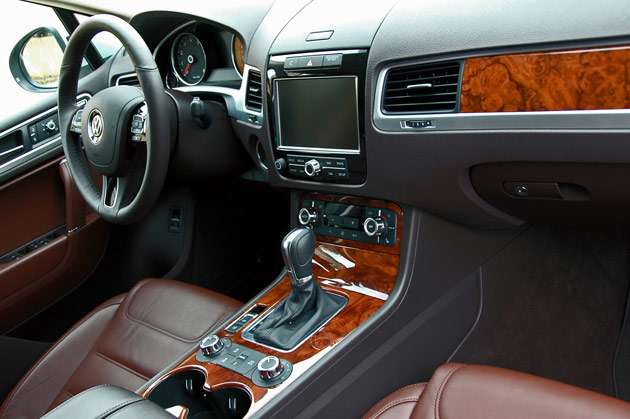
Perhaps the designers saved those curves no longer needed up front for the interior. It is convex and concave all over and truly nicer, with cross-stitching accenting the new hills and valleys. The redesigned front seats are comfy going the distance, the transmission tunnel has been reshaped to provide more legroom and the center console moved forward to provide more support. Ensconced on the new back bench with the front seats placed where we had plenty of room, there remained more than two inches between our legs and the front seats. The back bench also slides six inches fore-and-aft and reclines a few degrees.
The 6.5-inch touchscreen DVD system, which will be standard in the U.S., is easy to navigate and has a 3-D view with major landmarks built in. A 60-GB hard drive has 18 GB set aside for you to download your media. It works in conjunction with the seven-inch, 15:9 aspect ratio multifunction display in the dash, between the gauges. Color and brightness for both screens was excellent in every light condition we encountered.
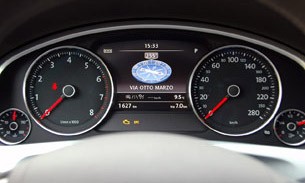
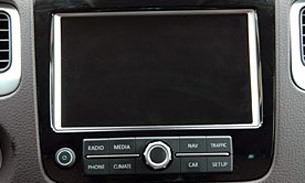
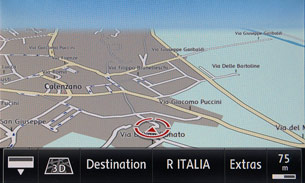
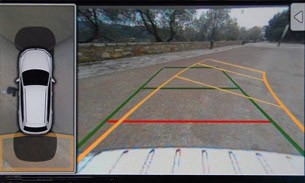
In fact, the new Touareg is replete with premium touches like an electronic parking brake, an electronic engine oil level display that replaces the dipstick, a start-stop button on the keyless entry model and a key that can be turned right or left to start the car on all models, an electronic tailgate that can be programmed to open to a preset height (to avoid scraping in low-hanging garages), ambiance lighting in the footwells and doors, four Area View cameras that provide a 360-degree view around the car, a panorama sunroof, park distance control (PDC), and the aforementioned bi-xenon headlights with LED daytime running lights.
Yet the full story isn't all "more" with this car, "less" and "fewer" play parts as well and not just concerning weight. There will be fewer option choices. On the V6 FSI and TDI there are three build choices. Base includes bi-xenon and LED driving lights, 18-inch wheels, DVD navigation and rearview camera, and 12-way power driver and passenger seats. The next level adds Vienna Leather, memory seats, the panoramic sunroof, wood trim and 19-inch wheels. The top of the peak model throws in the 12-speaker, 620-watt Dynaudio system; PDC; Smart Key; heated rear seats and steering wheel and 20-inch wheels. The Hybrid will be available only in that top trim level, albeit riding on 19-inch wheels wearing all-season low-resistance tires. Throw in the Terrain and Tow packages, and Volkswagen has reduced build options from more than 170 to about 20.
The first of those options, and the one that will surely be the least expensive when VW announces pricing, is the V6 FSI. More efficient than the current Touareg2 V6 FSI, the direct-injection lump will have 275 horsepower and 265 pound-feet. The one above that will be the BlueMotion V6 TDI, a common-rail turbodiesel with 236 hp and 405 pound-feet that comes on from 2,000 rpm. They both do the 0-to-62-mph run in 7.8 seconds.
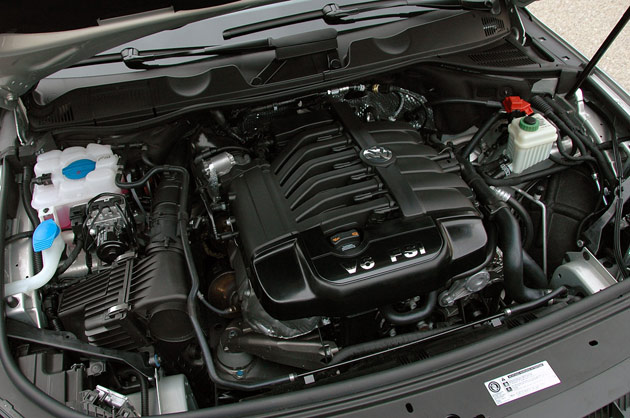
In Europe, those engines will get Stop-Start, but we won't. We will, however, get the eight-speed automatic transmission that is now standard throughout the range. The gearbox, which shifts faster than the current six-speeder and has a 20-percent larger spread, uses the top two gears as long-distance fuel-consumption-reducing ratios. At 80 mph the tach rests at just 2,200 rpm. Volkswagen hasn't released EPA cycle numbers yet, but you can expect something better than the 14 city/20 highway miles per gallon of the VR6 FSI and 18/25 of the current V6 TDI models.
It is the Hybrid that gets the marquee space, though. It mates a supercharged, direct-injection V6 TSI with 333 horsepower and 324 lb-ft of torque to a Hybrid Module powered by a nickel metal-hydride battery pack in what would be the spare wheel recess under the cargo area. The 288-volt battery pack with 240 individual cells has a peak output of 38 kW. It can propel the Touareg on electric power alone for about a 1.5 miles at speeds up to 32 mph. Stomp on the gas from a standstill and you get to 62 in 6.5 seconds because the combined power numbers jump to 375 hp and 428 lb.-ft.
The heart of the parallel hybrid system is the 121-pound, 15-inch wide circular Hybrid Module, which has a 47-hp electric motor and a disengagement clutch. Essentially what it does is act to engage or disengage the ICE and electric motor from each other or the drivetrain. As in every other hybrid, you can have just the V6 in use or just electricity or both, but by being able to disengage the electric motor completely, VW has kept the Touareg's off-road and towing performance. The 7,500-pound towing capacity – more than a GMC Sierra Hybrid and the same for all versions of the Touareg – wouldn't be possible if you couldn't set the electric motor entirely aside.
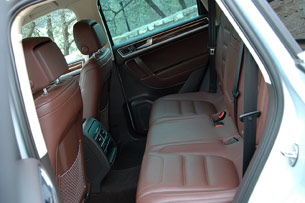
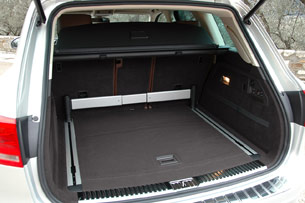
Speaking of which, that is what also enables the Touareg to "sail." When the engine isn't needed to help move the vehicle, it is disengaged from the transmission. When you are coasting down a hill, for instance, the disengagement clutch in the Hybrid Module unhooks the V6, the engine is shut off and the tachometer falls to zero. You notice you coast a lot further as well because there's no engine torque to drag on the driveline. This "sailing" can be done up to 100 mph.
How do they go? Don't let the 7.8-second time and the gap between the traditional and Hybrid version throw you off – none of them are slow and even the base engine, the V6 FSI, delivers fine motoring pleasure. Sure, it doesn't bolt from the line like the Hybrid, but on the move, its pickup, aided by the quick-shifting and additional cogs of the eight-speed automatic, never let a driver down. The diesel is a bit more peppy, but it is the Hybrid that gets moving most quickly when you sound the klaxon.
With the loss of the air suspension – which is tied to the 4XMotion and so won't be on any Touareg without the Terrain Tech package – road feel returns to the level of a middle-premium SUV. Cornering isn't table flat, potholes knock a bit louder, and bad roads make a bit more fuss, but it is all still premium. The engineers have done a good job letting you feel the loss of that 500 pounds, though – the cargo-ship stolidity of the current model is gone, replaced by a more capable, more nimble vehicle that offers more of everything all around. The new Touareg will show itself well when cross-shopped with VW's target competition.
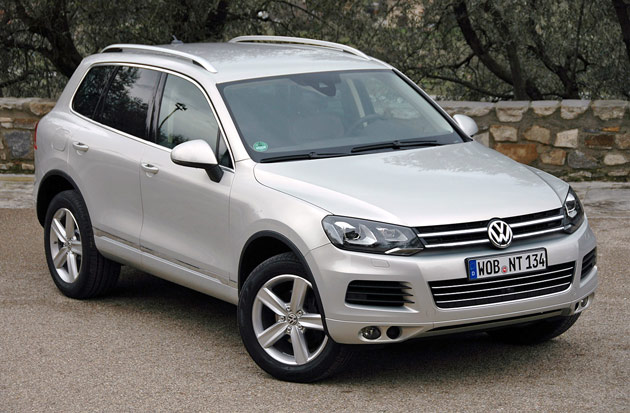
The Hybrid's features like stop-start and coasting were superb. As you brake to stop for a light, the engine shuts down and you roll to a stop on electric power. All systems are maintained, so power steering, brake boosting and the like remain on call. When you take your foot off the brake to pull away, you can roll away on electric power alone if you don't ask for a lot of gumption. If you need to get going right now, peak electric power comes in to move the car the first meter while the ICE comes on, silently, and spools up to take over on-the-go. It exhibits all the refinement you could eve want in such a system, on top of which you can do the off-road thing and pull an enormous trailer.
If Volkswagen prices the Touareg right when it hits the market later this year – and the officials in attendance gave every indication that pricing is a tied-for-first priority – then they won't need to worry about selling just 500,000 of these new Touaregs over its product life cycle. Provided VW can right the Touareg's troubled reliability legacy with this new model, we expect more Yankees will show up for this party and wouldn't even be surprised if enough showed up to request an American-sized slice of the sales pie.
Photos by Jonathon Ramsey / Copyright ©2010 Weblogs, Inc.



Sign in to post
Please sign in to leave a comment.
Continue